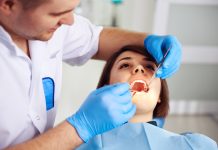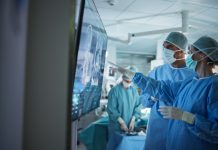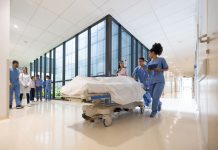MyBones explores the relationship between falls and fractures, and the importance of preventative care
Falls and fractures represent a significant cost to healthcare providers and care services. Hip fractures alone account for 1.8 million hospital bed days a year, costing the NHS a total of £1.1 billion. (1)
While the societal and personal costs are high, falls and fractures are often preventable. Embracing new preventative strategies is essential for reducing these costs and maintaining the health and independence of those at risk.
Osteoporosis and falls
Osteoporosis develops when bone mineral density and bone mass decrease. As bones lose their density, they lose their strength and flexibility.
For a person with normal bone density, a minor fall will likely not result in any long-term complications. For someone with osteoporosis, a minor fall from a standing height may result in a lengthy hospital stay or even be fatal.
This is because people with osteoporosis are more susceptible to fragility fractures. These are fractures which occur following a low-energy trauma, such as a fall from a standing height.
Whilst it can affect anyone, osteoporosis is most common in older adults, with half of women over 50 expected to be affected. (2)
Older adults are more likely to suffer a fall. In fact, one in three people aged over 65 are expected to have at least one fall a year. (3) This is a dangerous combination and means that elderly people are both more likely to fall, and more likely to suffer a fracture when they fall.
Preventing falls
Without falls many fractures would not happen. The causes are often complex and varied. Some falls are due to environmental hazards such as poor lighting or wet flooring. A substantial number are the result of balance issues associated with muscle weakness (sarcopenia).
Exercise is known to combat sarcopenia and improve motor function. However, exercise and strength training is not always effective or viable for everyone. Additionally, previous fractures can make people fearful of exercise and encourage sedentary lifestyles.
Low-intensity Vibration (LiV) therapy offers a solution
Low-intensity Vibration (LiV) therapy offers a safe and accessible solution. As the user stands on the vibration plate, the low magnitude, high-frequency vibration signal causes the muscles in their legs to contract and relax. This action strengthens the muscle fibres and improves balance, thereby reducing fall risk. Each session only takes 10 minutes a day.
A study of 710 postmenopausal women found those using a LiV plate reported fewer falls and fractures than the control group. (4) They recorded significant improvements in reaction time, movement velocity and quadricep muscle strength. This highlights the central role devices can play in fall prevention programmes, alongside other interventions such as exercise.
Reducing fractures
Unfortunately, not all falls are avoidable. Reducing fracture risk is key to reducing their severity.
Vibrations play a significant role in bone growth and development. Mesmesenchymal stem cells (MSCs) in bones have the potential to form bone, cartilage, or fat cells. What they produce is dependent on how much mechanical stimulation/loading they receive.
One way to positively influence MSCs is with vibrations. Through 35 years of research, Professor Clinton Rubin discovered that a vibration plate delivering a precise, targeted signal of 0.4g at 30hz will drive MSCs to produce more bone and less fat. (5) This increases bone mineral density and prevents and combats osteoporosis.
Several studies have established the effectiveness of LiV therapy. In one study, gains of up to 7.2% in spinal musculature and 3.9% in the cancellous bone tissue of the spine were seen in the most compliant users. (6)
It’s important to note not all vibration therapy is the same. Many high-intensity vibration devices, typically those which exceed forces of 1.0g, have significant side effects and are unsafe for users with conditions such as osteoporosis. Based on ISO and OSHA vibration standards, many high-intensity vibration plates are unsafe to use for more than a few seconds. Used correctly, Low-intensity Vibration plates are safe to use for up to 4 hours a day. (7)
Falls and fractures prevention
Low-intensity Vibration therapy offers an accessible and effective way to pre-emptively reduce fall and fracture risk. Shifting the focus towards prevention with LiV therapy would reduce costs to healthcare providers and improve patient quality of life. LiV devices are compact, cost-effective, and suitable to use at home, in clinics, and other care facilities.
The Marodyne LiV device is certified by the British Standards Institution (BSI) as a class IIa medical device. Find out more about the Marodyne LiV device at https://mybones.health/liv-device/.
References
1.Falls: applying All Our Health. [online] Available at: <https://www.gov.uk/government/publications/falls-applying-all-our-health/falls-applying-all-our-health> [Accessed 5 September 2022].
2. International Osteoporosis Foundation. ‘Broken Bones, Broken Lives: A Roadmap to Solve the Fragility Fracture Crisis in the United Kingdom’, 2018.
3.Al-Aama, Tareef. “Falls in the elderly: spectrum and prevention.” Canadian family physician Medecin de famille canadien vol. 57,7 (2011): 771-6.
4. Leung, K.S., Li, C.Y., Tse, Y.K. et al. Effects of 18-month low-magnitude high-frequency vibration on fall rate and fracture risks in 710 community elderly—a cluster-randomized controlled trial. Osteoporos Int 25, 1785–1795 (2014). https://doi.org/10.1007/s00198-014-2693-6
5. Pagnotti, G.M., Styner, M., Uzer, G. et al. Combating osteoporosis and obesity with exercise: leveraging cell mechanosensitivity. Nat Rev Endocrinol 15, 339–355 (2019). https://doi.org/10.1038/s41574-019-0170-1
6. Gilsanz, V., Wren, T.A., Sanchez, M., Dorey, F., Judex, S. and Rubin, C. (2006), Low-Level, High-Frequency Mechanical Signals Enhance Musculoskeletal Development of Young Women With Low BMD. J Bone Miner Res, 21: 1464-1474. https://doi.org/10.1359/jbmr.060612
7. Muir, Jesse et al. “Safety and severity of accelerations delivered from whole body vibration exercise devices to standing adults.” Journal of science and medicine in sport vol. 16,6 (2013): 526-31. doi:10.1016/j.jsams.2013.01.004

This work is licensed under Creative Commons Attribution-NonCommercial-NoDerivatives 4.0 International.











